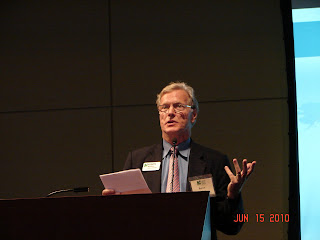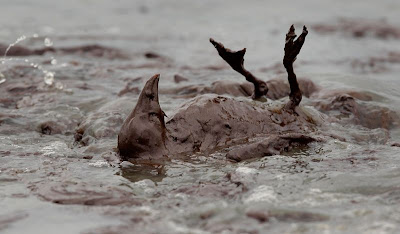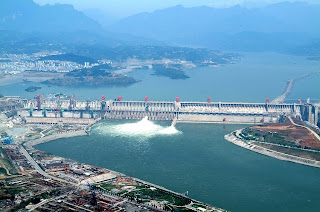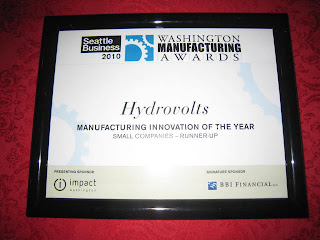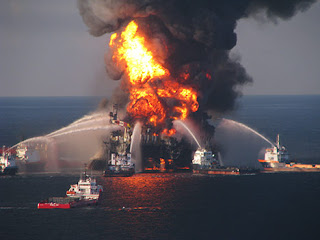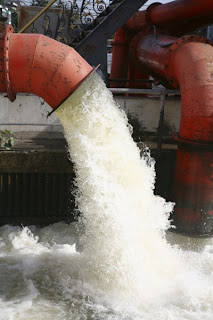Hydrovolts updates 27 Apr 2011 7:18 AM (13 years ago)
Hello again, I am finally going to blog regularly because a) our fans want it and b) I am writing this stuff up for PR and news anyway, and might as well get it all together. Look for regular posts, and Tweets even, now we have hired Michelle Holmes as our new Executive Assistant and marketing wizard. Michelle has a Masters in Environmental Studies from Evergreen College, worked in the Peace Corps in Africa, and has been a marketing manager for several companies. One of her tasks is to make me write blogs. I suppose it's inevitable.....
Now to updates:
Hydrovolts Class 1 small size turbine will be installed this Friday in Roza Irrigation canal for a month of testing in various configurations and sites.
Big turbine for India customer is being assembled and will be installed mid June for several months, with milestone date of Aug 15.
US Navy has requested Hydrovolts provide turbines for testing in september at Navy’s facility near Washington DC, at Navy expense
Student at US Naval Academy at Annapolis has demonstrated Hydrovolts turbines work as wave energy turbines, and Hydrovolts is now negotiating a Cooperative R&D Agreement with the Academy. Hydrovolts CEO Burt Hamner was an invited speaker to the Academy's meeting of the Society of American Military Engineers.
Hydrovolts has hired a new Marine Business Director with great success winning large Navy contracts. Brian Williams starts May 15.
Harvard engineering students have nearly completed their model Flipwing turbine and are testing it by towing it in Harvard's Olympic swimming pool. At least one Harvard student will be an intern for Hydrovolts working with Harvard this summer.
Company just recognized as an Artemis Top 50 Water Technology company, and as a Global Innovator by the Katerva Foundation. (yeah, I never heard of them either, www.katerva.org)
Company is presenting next week in San Francisco at the Investors Circle Spring Forum, and at TechConnect in Boston in June.
Company has retained the business advisory firm Sierra Asia to help find a business partner in China and begin our market entry process for China. Though this is daunting and even feels premature, it's necessary to protect our intellectual property and will take a while to accomplish.
Fundraising for Series A2 Preferred Stock proceeding steadily; $200k out of $600k is soft circled firm, and another $250k is soft soft. Full subscription expected by mid June, can close with $300k. Interested persons please contact
Hydrovolts will hold an investors open house and cocktails on Tuesday May 10 at 4-6 pm at the McKinstry Innovation Center. The McKinstry factory tour starts at 4:30. This is for potentially interested investors, current investors, and key business partners. Please RSVP to Burt@hydrovolts.com or 206 491 0945.
Hydrovolts Blog lives again 30 Jan 2011 7:54 PM (14 years ago)
We are re-launching the Hydrovolts blog after a break of several months. Hydrovolts co-founder Chris Leyerle started and maintained the blog, and he left Hydrovolts in July 2010 to become an entrepreneur in residence at Washington State University, http://leyerle.blogspot.com/. I, Burt Hamner, the other co founder and the CEO, am now the blogger in chief. I am learning as I go.
Hiatus 30 Jun 2010 10:49 PM (14 years ago)

Taking a break from blogging to focus on other things...
Will return to posting after a while.
Update: I am no longer with Hydrovolts. Check out my new blog.
Crude Behaviors 28 Jun 2010 10:58 PM (14 years ago)

Judge Feldman not only held numerous oil and gas interest stocks, but was trading them up to and including the morning of his fateful decision, and doing so out of an admitted realization that he had an appearance of ethical conflict. Feldman owned and was trading Exxon stock, a company whose Gulf of Mexico rigs were losing money at the rate of a half million dollars a day due to the moratorium, during the entire time he was assigned the case. Yet, failing to disclose his appearance of conflict on the record or recuse, Feldman nevertheless proceeded to issue a questionable decision clearly benefitting the oil and exploration industry he is so invested in.So why, when the Government appealed this decision, did they not raise the glaring conflicts of interest?
[snip]
Even more distressing is the fact that it has now been revealed from Judge Feldman’s 2009 financial disclosure, literally just filed and only released this week after demand resulting from his questionable ruling, that Feldman is very heavily invested in Blackrock Financial products. Blackrock is, of course, the single biggest shareholder in BP.
Eight Is Enough 22 Jun 2010 9:19 PM (14 years ago)
 Jon Stewart in one of his typically acerbic pieces on the promise of oil independence:
Jon Stewart in one of his typically acerbic pieces on the promise of oil independence:
Coming on the heels of President Obama's speech on the BP spill, and with video clips detailing 4 decades of imprecations and high-minded exhortations from 8 presidents, Stewart complains, roughly, "Fool me once, shame on you. Fool me twice, shame on me. Fool me 8 times, I am a freaking idiot."
We fail to demand real action from our leaders, or to hold them accountable for mouthing bromides. With our current president, I fear the audacity hope has become the folly of wishful thinking. As Pogo said, originally in a poster for Earth Day 1970, "We have met the enemy, and he is us."
Video here.
(h/t earth2tech)
Faint Hope 19 Jun 2010 3:26 PM (14 years ago)

Eric Pooley over at Grist has an excerpt from his forthcoming book which lucidly surveys the Obama Administration's timeline of timidity. He concludes:
It is a cruel irony that the epic disaster in the Gulf -- a wakeup call to the need to reduce our dependence on oil -- makes it harder to pass a bill that would help us do so. Expanded offshore drilling (and the revenue it would bring) was the chip Obama hoped to use to draw oil-state senators into a grand bargain that would also include subsidies for nuclear power and carbon capture and storage, with a modest carbon cap in return. The oil spill blew up that idea by taking expanded offshore drilling off the table, at least for now. With few chips left, Obama appears to be hoping that public anger over the spill can help drive a new version of the climate bill. Soon, we’ll know whether he really means it. Democratic leaders in the Senate have been floating the idea of an energy bill without a carbon cap -- which would be yet another failure of nerve by a group of legislators badly in need of adult supervision. Passing a real climate bill will be excruciatingly difficult. Waiting will only make it harder. It’s time for Obama to intervene on the Hill, silence the naysayers inside his own administration, harness the public mood, and make good on his promise to fight.So this is what the audacity of hope looks like--wishing for the First Nerd to remove his figurative glasses and punch back at the bullies. But he won't. Ever cerebral, Obama doggedly appeals to the non-existent good intentions of his opponents, believing that reason and patience will yield agreement. In time, onlookers feel contempt, not sympathy. The notion that Obama will risk any political capital to lead a fight is not a bold hope, but a limp wish.
Pooley hopes that public anger will prod a sclerotic Congress into passing a climate bill. However, public anger is attenuating from the steady trickle of bad news and is increasingly eager to look for other targets, particularly within the federal government. The oil lobby and their drill shills in the chattering classes are working hard, incredibly, to recast the oil disaster as an example of why government involvement is bad. (The argument, in defiance of both reason and evidence is roughly: Regulatory oversight failed, thus regulation is worthless, and so government should do nothing, except perhaps foot the bill.) The mob is searching for scapegoats of which to make an example, and the focus is punitive rather than constructive. It is absurd to hope that the public, exhausted from bad news, beset by economic gloom, incited by partisan hacks, and frustrated by collective impotence will spur a Congress captive of corporate interests to do other than pander to the electorate while they stroke entrenched incumbents.
Hope is not a plan. Obama's unwillingness to articulate a bold plan (or even a bold hope) contributes to the perception that our government is adrift. Worse, it reinforces the belief that government is incapable of solving problems, in turn making bold action even harder. On energy policy, this will guarantee the decline of American competitiveness. It is well past time for Obama to be a leader, not a mediator.
Hydrovolts Named 2010 Cleantech Open Semifinalist 16 Jun 2010 10:48 PM (14 years ago)

Last year Hydrovolts was one of the winners in the Pacific Northwest Region and went on to win the National Sustainability Award at the finals in San Francisco.
Leading this year's Hydrovolts team are Brian Peithman, Director of Engineering, and James Marvin, Director of Field Operations and Business Development. Hydrovolts continues to focus on irrigation canals and other constructed watercourses for initial turbine deployments, but also sees great value in applying the Flipwing technology to military applications where distributed renewable energy provides many benefits to national security and saves lives.
James spoke for the team in accepting the award:
The Cleantech Open is the world’s largest cleantech business competition. Its mission is to find, fund and foster entrepreneurs with big ideas that address today’s most urgent energy, environmental and economic challenges.
The program provides the infrastructure, expertise and strategic relationships to turn clever ideas into successful global cleantech companies. Since 2006, through its one-of-a-kind annual business competition and mentorship program, the Cleantech Open has enabled hundreds of clean technology startups to bring their breakthrough ideas to fruition, helped alumni contestants raise over $260M, and created an estimated 1,200 green collar jobs. Fueled by a network of more than 600 volunteers and sponsors, the Cleantech Open unites the public and private sectors in a shared vision for making America’s cleantech sector a thriving economic engine. For more information, visit www.cleantechopen.com and follow @cleantechopen on Twitter.
and Geir Hansen of Silicon Valley Bank
Hydrovolts is one of 16 semifinalists in the Pacific Northwest and one of 104 semifinalists from 22 states and 91 cities across all 5 regions of this year's competition. Good luck to our fellow semifinalists!
Wooden Turbines 13 Jun 2010 10:36 PM (14 years ago)

“Wood is a porous, homogeneous material — so it has better mechanical and hydrological characteristics than today’s conventional materials such as composites and steel. The major challenge is the actual assembly process, but we believe we have found a good solution.” He points out that using wood in turbine blades is also an environmentally sound choice, especially in a lifecycle perspective.That wood is porous doesn't seem very significant, especially since the pine they plan to use is laminated. Many other materials are "homogeneous" too and the lifecycle advantages are rather minor. At 23 meters long, blade durability may be an issue too, and frequent replacement of weaker blades is no lifecycle or environmental boon. The allegedly better mechanical and hydrological aspects are not further described.
The plan to use floating deployment (as Hydrovolts does) is smart as it is faster, simpler, much cheaper, and doesn't need specialized boats. Still, the technology itself doesn't seem particularly different otherwise, apart from the wooden blades. So, why wood?
80% of the [turbine] can be recycled after its life span, which is more than 30 years. For example, our turbines are made out of glued wood. This material can handle tough ocean environments and they last very long. After the turbines' life end, they can be chopped and used in a bio energy power plant for example.They've done some very clever things in Norway with renewable energy, so it will be worth watching to see how this turns out.
Hydra Tidal has, in cooperation with Harstad University College and Kunnskapsparken Nord AS(Science/Competence park), made a report about CO2 emissions in connection with the production of a complete Morild power plant. CO2 emissions are 40% lower than that of onshore wind power.
Putting Litter to Use 10 Jun 2010 8:43 PM (14 years ago)

The Corona Save the Beach Hotel, designed by German artist HA Schult, is open until June 7 near Rome's Castel Sant'Angelo, which is located along the Tiber river.This is not Schult's first such effort:
"In the ocean, the trash from all continents meets one another. The trash from Africa meets the trash from Europe, meets the trash from South America," Schult said, pointing to the guitars and shoes plastered across the building.
"The environmental problem is a global problem. We are living in a planet of garbage," said Schult, whose most famous work is "Trash People," an installation of 1,000 human figures made out of trash.
"Trash People" was installed under the Brooklyn Bridge in New York, in front of the Giza Pyramids in Egypt, in Red Square in Moscow, at La Defense in Paris, and along the Great Wall of China.
Training Commuters is Difficult 9 Jun 2010 12:18 AM (14 years ago)

Doty suggested that this result moves the state closer to running high-speed trains on the same tracks:
The same equipment standards that we have qualified for, the equipment we're looking for, are the same equipment standards for high speed rail. So in effect what we've done is we found the process that needs to be followed and we've done it successfully. Now, they can take our process and expand it for high speed rail, so it is absolutely a precursor for high speed rail.Well, that's a bit like saying that building a Volkswagon Bug paves the way to building a Porsche Carrera.
I suppose one can learn something transferable in the process, and the wires strung to power the trains may work for high-speed too. However, there would be a lot of expense on those particular tracks to achieve the necessary grade separation critical to allowing safe operation.
Still, replacing fossil fuel engines with electric ones is a good step, and if it eases the existential financial pressure on Caltrain it's great. The system has declared a fiscal emergency for the second year in a row, and is projected to lose $36M this year. On the table: fare increases and service cuts. The Bay Area commute is notoriously bad: the average length of time for commuters to San Jose is 23 minutes; to San Francisco it's 34 minutes. Almost 2,250,000 people or 68% of the working population commuted alone by car in the Bay Area in 2000. With an average commute length of 15 miles and a nominal per mile cost of 50 cents, the aggregate daily cost of this commute is more than $16,000,000. By contrast, the Caltrain daily deficit is less than $100,000.
The solution is more and more affordable transit options, not less. Of course, people have to see that public transit is better--faster, lower cost, less stress, etc. Raising fares and cutting service won't do that, but will instead just accelerate the downward spiral.
(h/t Polizeros)
A Sad Day for Our Oceans 7 Jun 2010 10:17 PM (14 years ago)
 Tomorrow is World Oceans Day. Although proposed by Canada at the Earth Summit in 1992, it was made official only last year.
Tomorrow is World Oceans Day. Although proposed by Canada at the Earth Summit in 1992, it was made official only last year.
Tomorrow is also Day 50 of the the worst ecological disaster in US history. (My opinion--there is some depressing competition.)
This year's Oceans Day theme, ironically enough, is "Oceans of Life."
Meanwhile, back at the Wingnut Wurlitzer: Jindal wants to keep drilling. Chevron agrees. Murkowski worries about liability exposure for big oil. Inhofe too. Cornyn thinks we shouldn't try for bold steps on energy policy. Shell Oil says drilling in ANWR is safe. Palin asserts the spill validates "drill, baby, drill." BP remains a corporate psychopath.
Words fail.
Permitting Insanity 6 Jun 2010 10:32 PM (14 years ago)

The Cape Wind offshore wind farm is closer than ever to the start of construction. Just more than a week after the explosion of BP's Deepwater Horizon platform, US Interior Secretary Ken Salazar gave formal approval, saying:
After careful consideration of all the concerns expressed during the lengthy review and consultation process and thorough analyses of the many factors involved, I find that the public benefits weigh in favor of approving the Cape Wind project at the Horseshoe Shoal location. With this decision we are beginning a new direction in our Nation’s energy future, ushering in America’s first offshore wind energy facility and opening a new chapter in the history of this region.
The project had previously won support from six state governors, many of whom hope to see wind farms built off their state's coastlines as well.
Developer Cape Wind Associates has spent nine years and $45M on analyses and studies to deal with endless procedural and legal roadblocks. Opponents of the project have spent a reported $20M to throw up all manner of objections: Bird and bat mortality. Impaired fisheries. Navigation problems. Ugly views. Damaged lobster habitat. Loss of cultural and historical value. Costly power.
Offshore wind farms have been built and operated in Europe for decades. These objections have all proven baseless, over-blown, or amenable to common-sense mitigation. No disasters predicted by opponents there have been borne out. Cape Wind will be economically viable: they have signed a power purchase agreement with National Grid at a competitive price. National Grid president Tom King remarked:
It’s truly fitting that the next milestone in our nation’s clean energy revolution is taking place in the Bay State and New England. We believe this project will provide long-term economic and environmental benefits here, throughout the region and across the nation. We absolutely must develop our homegrown renewable energy resources if we are to meet state and federal renewable goals, secure our energy future and seize the leadership position in the global clean energy economy.Opponents of Cape Wind and similar renewable energy projects offshore need to take a hard look at their reasons for obstruction. Unless they don't own a car, live in an unheated yurt, grow their own food, and never buy any product not made locally of local materials they depend on the modern energy economy too. From where will that energy come? This is what the end of the Age of Oil looks like. While the transition from oil will take decades, alas, our future energy must inevitably come from something else. Concern trolling about impacts to birds, marine life, fisheries, views and the rest cannot now be taken seriously compared to this:
Our future energy security will require more than one offshore wind farm per decade. Maine recently announced its intention to foster development of offshore wind that would generate more than twice the state's current electrical needs by 2030. There are many imbalances between the dirty fossil energy of our present and the clean renewable energy of our future. These imbalances include disparate subsidies, disproportionate lobbying power, vast differences in available capital, and a stark divergence about what is in the public's long term interest.
So many things need to change, but redressing the unconscionable and indefensibly vast divergence in permitting burdens and timelines would be a good place to start.
Hydropower Potential - IV 4 Jun 2010 10:57 PM (14 years ago)

1. China - 179,056 MWIt's interesting data for several reasons.
2. Brazil - 81,955 MW
3. United States - 78,054 MW
4. Canada - 75,287 MW
5. Russia - 46,756 MW
6. India - 39,546 MW
7. Norway - 29,317 MW
8. Japan - 22,089 MW
9. France - 20,850 MW
10. Sweden - 16,266 MW
First, China's capacity is more than double that of the number two country, Brazil.
Second, all of the so-called BRIC countries (Brazil, Russia, India, and China) are in the top six; there is a good correlation of the world's fast-growing and significant economies with hydropower capacity to supply the electrical power these countries need to sustain their growth. The significant investment in renewable generation merits recognition at least as much as the opprobrium over their investment in dirty fossil energy.
Third, hydro dwarfs other renewables in the US, with only wind at the same order of magnitude:
Wind 35,296 MWFourth, comparing this data to the capacities cited by the US Energy Information Administration (EIA) shows that there has been little added hydro capacity since 2008, the last year available, but a healthy increase in wind capacity and substantial percentage increases in solar and biomass/biogas.
Biomass 9,391 MW
Geothermal 3,153 MW
Solar (PV) 1,488 MW
Biogas 1,047 MW
Solar (CSP) 900 MW
Finally, comparing these numbers to the overall US generating capacity of just more than a terrawatt (1,000,000 MW) shows how relatively paltry is the contribution of renewable sources to our electrical generation.
There is still a long way to go.
Hear My Train A-Comin' 2 Jun 2010 10:58 PM (14 years ago)
Would you take a high-speed train that doesn't stop?
The video shows the "non-stop MRT system" of its Taiwanese inventor Peng Yu-lun and is (I think) in Mandarin, but you can get a pretty good idea nonetheless of how passengers use ingenious reusable shuttles to get on and off a high speed train without it stopping or even (much?) slowing down:
English explanation here.
Possible problems:
- Trains are taller, so existing bridges might need to be rebuilt
- Not everyone in the train can fit in the shuttles, so they couldn't all get off en masse at the stadium station to go to the ball game
- Acceleration of the shuttle may be too exciting for those with heart problems or other health issues
- Most people are too terrified of derailments anyway
- US patent 4,425,851 from 1984. Why did no one do this already?
- A great Peter Tosh tune would be obsolete:
Update: A friend, working in the PRC for many years writes:
It is Mandarin. The platform announcer tells travellers that train 168 non-stop from Beijing to Guangzhou is approaching the station. Passengers travelling in the direction of Guangzhou are to board the shuttle. Then the train's announcer tells passengers disembarking at Wuchang to board the train's shuttle. Lastly there is a welcome to Wuchang station announcement. The inventor explains that he has put together a simple mechanical frame just to demonstrate the basic concept. He then describes the passenger movement for boarding and exiting the non-stop train from Beijing to Guangzhou.
This is very interesting!
Augmenting Thermal Power Plants with Hydropower from Cooling Water 1 Jun 2010 12:10 PM (14 years ago)

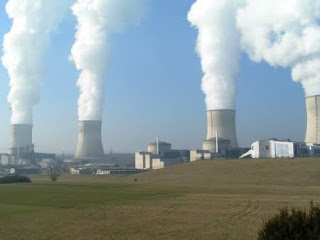 |
Once the steam has passed through the turbine it moves into a condenser where it is cooled back into liquid water, and circulated around to be heated again. Many of the condensers use water to cool the steam. Some plants use a closed loop of cooling water, where the cooling water is itself cooled; in nuclear plants this is the purpose of the tall cooling towers. Steam that escapes is replaced by a fresh supply of water, which is why these plants are typically sited near rivers or by the ocean where there is a large continuous water supply.
Other plants use an open loop or once-through water for their cooling, where water is drawn in continuously for cooling, then discharged back into the river or ocean. These discharges are almost always gravity flows rather than pumped, and these discharges of large amounts of water, running continuously in artificial channels, are perfect for Hydrovolts turbines to generate power, augmenting that made by the main part of the plant. Hydrovolts turbines can generate additional power at modest cost by harnessing these untapped flows; the electricity is sent via the existing transmission infrastructure.
Like most other artificial water flows in constructed waterways, little or no permitting is needed because environmental impacts are minimal. As a result, cost is low and speed of implementation is relatively rapid. This is a solution that lets us take a small, but quick step to a better energy future.
Big Business Responds to Climate Change 29 May 2010 10:41 PM (14 years ago)

- 70% of the world's largest companies plan to spend more on efforts to combat climate change
- 80% plan to spend more on energy efficiency measures
- 65% plan to develop products and services related to climate change
- 63% pan to increase transparency of reporting on related areas such as environmental performance, energy use and carbon emissions
- Nearly 50% plan to spend at least 0.5% of revenue on such measures as energy efficiency
With all the uncertainty following Copenhagen, many business commentators were expecting the momentum in climate change investments to slow. Our research has shown something very different.It's quite surprising that business is leading the way in addressing a serious environmental problem on which the public shows increasing confusion and ambivalence. It is tempting to think that business is perhaps starting to see the costs and benefits more clearly; however, it may be more about keeping customers happy than about the operational bottom line: about 90% of the surveyed firms reported that their actions were due to customer demand.
Washington Manufacturing Awards 27 May 2010 10:39 PM (14 years ago)
Nearly 100 companies were nominated for awards, and Hydrovolts was one of three finalists for the Innovation award. Companies were chosen
...by a panel of experts based on criteria that [included] revenue growth (relative to the industry), capital investments, leadership, employee training programs, production quality, productivity, energy conservation and other factors.John Vicklund of Impact Washington helped emcee the awards sponsored by Seattle Business Magazine and RBI Financial. The reception and dinner was held in the Columbia Tower Club, high atop Seattle's tallest building with a sweeping view of the city and Puget Sound.
Rogers Weed, Director of the Washington State Department of Commerce gave the keynote address on the state and future of manufacturing in Washington. He has a dual focus on aerospace manufacturing because of its size and historical importance and on cleantech "because the Governor told me to" (laughter.) Rogers noted that the economy was improving and recovering from the loss of 190,000 jobs in the state. GDP has grown in Washington for the past 3 quarters, and he sees no likelihood of a "double-dip" recession. Asia remains huge to the state's economy and our export economy remains a national trend-setter not only in exports, but in manufacturing and manufacturing "value-add." Rogers believes and expects Washington to be a leader in the global economy.
In all, a fun evening with good food, a crisp program and great networking with old friends and new acquaintances. Thanks to Impact Washington and the sponsors for the recognition, and hearty congratulations to our friends at MicroGREEN Polymers, who won the top prize!
Scalable 25 May 2010 10:57 PM (14 years ago)

The Hydrovolts turbine is scalable in two fundamental ways.
First, the Hydrovolts turbine can be built in nearly any size, from very small to quite large. More importantly, the turbine's cross-axis design is rectangular, so it can be built in a broad range of different dimensions. Turbines can be built that are very wide but not very high, or they can be built more squarely. Propeller-type axial turbines always have a circular swept area, so they are ill-suited to water channels that are, for example, broad and shallow. Even with a cowling such turbines are not as adaptable because they cannot scale to arbitrary dimensions like the Hydrovolts turbine.
Second, the typical Hydrovolts turbine is a micro-scale device, and will generate 5-20kW in typical water flows. In very large channels multiple turbines can be deployed side-by-side in the channel, scaling up the power produced by deploying multiple turbines together. Where the water course is deep, turbines can also be positioned one above the other to take advantage of the height of the water column. Turbines can also be spaced one after the other down a water course. Even though any turbine slows the water as it extracts energy, gravity re-accelerates the water as the channel slopes away. Hydrovolts expects turbines typically can be placed 10 per mile, but the maximum rate will depend on the specific watercourse geometry.
Scalable is good. Power from Water.
Deepwater Horizon Causes and Lessons 22 May 2010 1:48 PM (14 years ago)

The principal conclusion pulls no punches:
What can be addressed now is the larger issue that a flawed, risky well plan for the MC 252 well was approved by the MMS, and BP, Anadarko and Mitsui management. Similar or identical plans were undoubtedly approved and used by many operators on other wells drilled in the Gulf of Mexico. A plan that does not include enough cement to overlap the final and previous casing strings, and that does not require running a cement-bond log to ensure the integrity of the seal is a defective plan. The fact that there have not been blowouts on previous wells does not justify the approval and use of an unsafe plan.Similar or identical plans. There are currently 3,858 other offshore platforms in the Gulf of Mexico, each of which can have as many as 20 wells.
Offshore oil drilling is not the solution to our energy problems. It is a reckless attempt to perpetuate our failing energy system, a system which cannot be sustained. It stands in the way of advancing real energy solutions. Time grows short.
Spewing Nonsense 21 May 2010 10:51 PM (14 years ago)

At first, BP insisted that any leak was minor, at most 1,000 barrels per day (BPD). BP stuck stubbornly to this figure for a week until the National Oceanographic and Atmospheric Administration (NOAA) announced on April 28 that the rate was more like 5,000 BPD.
BP has tried very hard to control information about the disaster. It was only a week and half ago, under intense pressure, that they released video of the erupting wellhead:
5,000 BPD remains BP's official figure, but virtually no one believes it. By May 1, using just satellite imagery, estimates were ranging up to 25,000 BPD. Within two weeks, after examining video, another expert estimated the flow as high as 70,000 BPD. Wednesday, after viewing newer video, he raised his estimate to at least 95,000 BPD.
BP stubbornly sticks to the rate of 5,000 BPD, even though most credible third party experts believe the actual number is 20 times higher or more. Yet their own actions and statements show they don't even believe it themselves.
A week ago BP managed to insert a smaller tube as a siphon into the larger tube on the sea floor. Using this siphon, they have managed to suck some of the spewing oil to a boat. Initially BP claimed that they were siphoning 1,000 BPD. Then the figure rose to 2,000 BPD. Then 3,000 BPD. A few days ago they announced that they had reached 5,000 BPD.
The only problem was live video of the oil eruption continued to show enormous amounts, perhaps most of the oil, going uncontained and unsiphoned into the Gulf. So, obviously 5,000 BPD could not have been correct for both the amount coming out and the amount being siphoned. So what did BP do? Today they announced that well, actually, they were only siphoning 2,200 BPD, less than half their earlier "estimate."
Their estimate?
What are they doing with the oil they are siphoning? Can't they measure it? If the other end of the siphon were hooked up to a tanker, or refinery you know they would be measuring it exactly. To the barrel. It beggars belief that they don't know or can't figure out what they are doing.
So rather than admit what almost everyone else already knows, that much more than 5,000 BPD is spewing daily, BP must pretend that they are being even less effective in their meager mitigation efforts. They are lying to us.
BP is fully invested in pretending that the "spill" is minor and under control. Thus the obstinacy about the size. So too the generous "estimates" of the amount they are siphoning. It also explains the unprecedented heavy use of toxic dispersants and the almost total silence about the vast plumes of sub-surface oil. BP is working desperately to deny how much is spilling, to exaggerate how much they are recovering, and to try to keep as much as possible from coming to the surface where it can be seen and measured more easily. That all this may be making the ecological disaster much worse is just not as important as trying to protect the last frayed bits of their tattered public image.
Criminal is the only word we should apply to a company more interested in performing damage control to their reputation than to the world's oceans.
Update: It seems there's also a purely economic reason for BP to fib about the amount of oil gushing forth--they have to pay royalties of 18.75% on the value of any amounts "wasted."
Update 2: Documents released in Congressional testimony this week show BP knew it was lying:
When BP was citing the 1,000 barrel per day figure to the American people on April 28, their own internal documents from the day before show that their best guess was a leak of 5,768 [sic] barrels per day and their high estimate was more than 14,000 barrels that were spilling into the Gulf every day.
Ice to Eskimos 20 May 2010 2:50 AM (14 years ago)

There are many reasons not to drink bottled water.
Bottled water costs more than gasoline. It costs up to 10,000 times more than tap water. It uses 2,000 time as much energy. It has 100 times the life cycle costs.
Contrary to what many believe, it is not healthier. It's not even safer, since the FDA has jurisdiction only over the approximately 30% of water bottles that are shipped between states. Bottled water testing is haphazard and often quite lax. Meanwhile, the EPA has jurisdiction over all water systems that serve more than 25 people. Tap water is tested more rigorously and more frequently too. Check your local water utility's report here.
Bottled water is an environmental atrocity:
According to the Pacific Institute, based on the quantity of U.S. bottled water sales reported by the Beverage Manufacturers Corporation for 2005, 38 billion plastic bottles were sold in the U.S. which used 900,000 tons of plastic, requiring 1.7 million barrels of oil, to make the #2 PETE bottles typically used for commercially bottled water. The production of the plastic water bottles created 2.5 million tons of carbon dioxide, a greenhouse gas contributing to climate change. According to NBC News, the number of water bottles consumed by the U.S., if laid end-to-end, could encircle the Earth 150 times each year. Less than 1/4th of these bottles are recycled, according to the Container Recycling Institute. Most water bottles end up in the landfill, where the plastic may decompose after 1,000 years.The plastic ends up in our oceans since as little as 25% of the bottles and fewer of the caps are recycled.
Not included in these calculations is the energy required to bottle and transport water from the sources, especially from such countries as France, Fuji, and Finland to the top consumer nations of the U.S., Saudi Arabia, Brazil, and elsewhere. The additional environmental impact of the long-distance shipping of bottled water adds many times to the environmental impact of the bottled water “carbon footprint.”
Still want to drink bottled water? Perhaps you have been hoodwinked by clever marketing.
Do something good for yourself, your bank account and the Earth. Get a reusable water container and learn where your local water fountains are.
Crude Strategies 18 May 2010 12:09 PM (14 years ago)
The situation in the Gulf is so grim humor can't rise above the sardonic. Thank goodness the problem is relatively small.National Security Threats Too Great 17 May 2010 11:08 AM (14 years ago)

National Security Threats Too Great
by James Marvin
The United States has to pass comprehensive climate and energy legislation. The longer we wait, the more difficult it will become to address the issue. Whether the American Power Act will carry the day, or some other legislation already introduced, remains to be seen. Doing nothing though, is not an acceptable answer and whatever the solution turns out to be it has to be pragmatic and it has to be timely.
Where you stand is where you sit and from where I sit our country’s dependence on foreign oil is a national security issue. It is costing American lives and one could say it is costing America itself. Comprehensive energy and climate legislation, no matter whose it is, is where we have to go as a nation. It will provide incentives for new energy solutions. It will put a price on pollution. It will address existing energy technologies appropriately. It will keep dollars out of the hands of extremest groups, and it will help keep America safe.
What our country needs now, and what the world needs in terms of leadership, is legislation that addresses energy and climate change holistically. Lasting change is going to take time and will require patience, persistence, and perseverance. But it has to start now. The longer it takes to address the issue, the more difficult the solution is going to be.
In the end, comprehensive energy and climate legislation will have to be an amalgamation of disproportionate ideas, values, and solutions. The juggernauts will have to willingly embrace a new identity and it is everyone’s responsibility to help them transform.
At the McKinstry Innovation Center 14 May 2010 10:54 PM (14 years ago)

Looking from the entrance towards the kitchen and dining area.
View down the length of the space showing some of the open collaborative area. Skylights make use of artificial lighting mostly unnecessary during the day.
One of the several meeting rooms in the middle of the floor. Each is built with recycled railroad ties, aluminum and glass. The green LCD display shows the room is available; the panel allows room reservation in advance.
A welcoming and open space at the north end of the floor has already seen its first party. Storage, sink, built-in ice maker and wine fridge suggest there will be more!
One of two large conference rooms at the end feature a gorgeous split slab table top from a salvaged tree. The McKinstry shop building is on the left, with a view of downtown Seattle in the distance.
The Hydrovolts team meets with engineers from Markey Machinery to discuss next steps in the intrumentation and testing of the Hydrovolts Alpha-1C Flipwing Turbine prototype. (L-R: James Marvin, Hydrovolts Director of Field Operations and Business Development; Gary Nishimura, Markey Machinery Engineer; Burt Hamner, Hydrovolts Co-founder and CEO; Peter Hammerschlag, Markey Machinery Chief Engineer; Brian Peithman, Hydrovolts Director of Engineering)
Hydrovolts' office. There are still boxes to unpack and things to hang up.
In a few weeks we will host an open house for our customers, partners, investors, vendors, families and friends. By then we will be fully installed and charging ahead. We look forward to seeing you and showing you both our fabulous new digs and also sharing some of the exciting developments of the past few weeks.
Hydrovolts
McKinstry Innovation Center
210 South Hudson Street
Suite 330
Seattle, WA 98134-2417
206-658-4380
Distributed Hydropower from Wastewater 12 May 2010 10:33 PM (14 years ago)

Because of the ingenious cross-axis design of the Flipwing, they can also generate power even in flows that are not clean, or even free of effluvia--flows like those found in sewer and wastewater systems in nearly every community.
There are 16,583 wastewater treatment plants in the United States serving nearly 3/4 of the population. There is growing interest in treating wastewater as a resource rather than something simply to be disposed. The biosolids have obvious application as fertilizer. The sludge can potentially be turned in to energy. Sewage can produce methane for fuel. Washington the Budd Inlet Treatment Plant has a pilot program to do just this. Treatment plant sites also lend themselves to solar installations. There are lots of ways to turn this waste into economic value.
As is the case with any site suitable for hydropower, the flow must be natural, moving due to gravity rather than to pumping. Sewage facilities like Seattle's Brightwater would not likely be customers as they would have few, if any, stretches of sufficiently strong and free flow. However, there are many facilities with suitable flows because plants and piping infrastructure are cheaper to operate where gravity can be used and the cost of pumping avoided. Treatment plants are typically sited to to seek this advantage.
Using wastewater flows to make power is a relatively new idea, but not unprecedented:
The first hydroelectric plant in Australia to generate power from treated sewage has been switched on at North Head sewage treatment plant as part of a New South Wales plan to reduce greenhouse gas emissions and generate green energy.It is great to see this happening. This project used a 60-foot drop which not all potential projects would enjoy. A hydrokinetic approach would work is many more flows as long as their was a fast enough flow, 2 m/s or more.
The hydro project was installed as part of a $150 million upgrade to the sewage treatment plant, government reports indicate.
The hydropower plant works by capturing energy from treated wastewater falling down a 60- meter shaft and will generate enough green energy to power almost 1,000 homes for a year, the government reported.
The new hydro plant will reduce Sydney Water’s greenhouse gas emissions by more than 12,000 tons a year, reports indicate.
Three wastewater treatment plants, in Washington, New York and Oregon, have inquired so far about purchase of Hydrovolts turbines.





